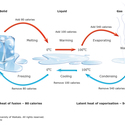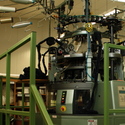A ceramic1 is an inorganic2 non-metallic solid made up of either metal3 or non-metal4 compounds that have been shaped and then hardened by heating to high temperatures. In general, they are hard, corrosion-resistant and brittle.
'Ceramic' comes from the Greek word meaning ‘pottery’. The clay-based domestic wares, art objects and building products are familiar to us all, but pottery is just one part of the ceramic world.
Nowadays the term ‘ceramic’ has a more expansive meaning and includes materials like glass, advanced ceramics5 and some cement systems as well.
Traditional ceramics – pottery
Pottery is one of the oldest human technologies. Fragments of clay6 pottery found recently in Hunan Province in China have been carbon7 dated to 17,500–18,300 years old.
The major types of pottery are described as earthenware8, stoneware9 and porcelain10.
Earthenware is used extensively for pottery tableware and decorative objects. It is one of the oldest materials used in pottery.
The clay is fired at relatively low temperatures (1,000–1,150°C), producing a slightly porous11, coarse product. To overcome its porosity, the fired object is covered with finely ground glass powder suspended in water (glaze12) and is then fired a second time. Faience, Delft and majolica are examples of earthenware.
Stoneware clay is fired at a high temperature13 (about 1,200°C) until made glass-like (vitrified). Because stoneware is non-porous, glaze is applied only for decoration. It is a sturdy, chip-resistant and durable material suitable for use in the kitchen for cooking, baking, storing liquids and as serving dishes.
Porcelain is a very hard, translucent14 white ceramic. The earliest forms of porcelain originated in China around 1600BC, and by 600AD, Chinese porcelain was a prized commodity with Arabian traders. Because porcelain was associated with China and often used to make plates, cups, vases and other works of fine art, it often goes by the name of ‘fine china15'.
To make porcelain, small amounts of glass, granite16 and feldspar17 minerals are ground up with fine white kaolin18 clay. Water is then added to the resulting fine white powder so that it can be kneaded and worked into shape. This is fired in a kiln to between 1,200–1,450°C. Decorative glazes are then applied followed by further firing.
Bone china – which is easier to make, harder to chip and stronger than porcelain – is made by adding ash from cattle bones to clay, feldspar minerals and fine silica19 sand.
Advanced ceramics – new materials
Advanced ceramics are not generally clay-based. Instead, they are either based on oxides or non-oxides or combinations of the two:
- Typical oxides used are alumina20 (Al2O3) and zirconia21 (ZrO2).
- Non-oxides are often carbides, borides, nitrides and silicides, for example, boron carbide (B4C), silicon22 carbide (SiC) and molybdenum disilicide (MoSi2).
Production processes firstly involve thoroughly blending the very fine constituent material powders. After shaping them into a green body23, this is high-temperature fired (1,600–1,800°C). This step is often carried out in an oxygen-free atmosphere24.
The high temperature allows the tiny grains of the individual ceramic components to fuse25 together, forming a hard, tough, durable and corrosion-resistant product. This process is called sintering26.
Applications of advanced ceramics
Advanced ceramic materials are now well established in many areas of everyday use, from fridge magnets27 to an increasing range or industries, including metals production and processing, aerospace, electronics28, automotive and personnel protection.
In modern medicine, advanced ceramics – often referred to as bioceramics – play an increasingly important role. Bioceramics such as alumina and zirconia are hard, chemically inert29 materials that can be polished to a high finish. They are used as dental implants and as bone30 substitutes in orthopaedic operations such as hip and knee replacement. Find out more on the uses for advanced ceramics.
Nature of Science
Progress in the advanced ceramics field has come about as a consequence of creative and imaginative thinking by materials scientists. Thinking ‘outside of the square’ can sometimes lead to the solving of an irksome problem.
Related content
Find out more about what clay is in this article. Explore further the uses for advanced ceramics, including O-Sialons, oxides and nitrides and materials for hypersonic vehicles.
Activity ideas
Try these activities in your classroom:
- Investigating clay: investigate some of the properties of clay such as moisture content, shrinkage and strength.
- Sialons – Ian Brown video clips: watch videos of Dr Ian Brown talking about sialons and then answer a series of graded questions related to the content.
- ceramic: An inorganic non-metal material that can be shaped and hardened by firing at high temperature to form a hard, strong and endurable body.
- inorganic: Atoms and molecules that are of inanimate (non-biological) origin.
- metal: Any of a category of elements that usually have a shiny surface, are generally good conductors of heat and electricity and can be melted or fused, hammered into thin sheets or drawn into wires (for example, copper).
- non-metal: A chemical element that forms acidic oxides and is a poor conductor of heat and electricity (e.g. sulfur).
- advanced ceramics: Substances based on metal oxides like alumina (Al2O3), inorganic non-metal oxides like silica (SiO2) and nitrides like silicon nitride (Si3N4). Unlike traditional clay-based ceramics (pottery), advanced ceramics do not necessarily need to be earth-derived.
- clay: A naturally occurring fine-grained material formed from the chemical weathering of feldspar minerals found in rocks.
- carbon: A non-metal element (C). It is a key component of living things.
- earthenware: A common pottery material used to make tableware and decorative objects.
- stoneware: A type of pottery that is non-porous and opaque. Stoneware clay is fired at a high temperature (about 1200 °C) until made glass-like (vitrified). It is a sturdy, chip-resistant and durable material suitable for use in the kitchen for cooking, baking, storing liquids and as serving dishes.
- porcelain: A very hard, translucent white ceramic. Because porcelain was associated with China and often used to make plates, cups, vases and other works of fine art, it often goes by the name of ‘fine china’.
- porous: Containing pores, holes or cavities which may be connected (high porosity) or not well connected (low porosity).
- glaze: A coating of metal oxides and silica applied to the surface of pottery items. When fired, the glaze fuses into a glassy-like solid. Glazes are used to colour, decorate and waterproof pottery.
- temperature: A measure of the degree of hotness or coldness of an object or substance. Temperature is measured with a thermometer calibrated in one or more temperature scales. Kelvin scale temperature is a measure of the average energy of the molecules of a body.
- translucent: A substance that light can pass through easily but that will cause the light to scatter. Objects are not clearly visible when viewed through a translucent substance.
- fine china: A type of pottery, also known as porcelain, that is translucent and quite strong although it looks delicate.
- granite: A common type of crystalline igneous rock that is rich in the minerals quartz, mica and feldspars.
- feldspar: Any of a group of rock-forming minerals that make up a large proportion of the Earth’s crust.
- kaolin: A white clay mainly made up of the mineral kaolinite. It is used extensively in the production of ceramics.
- silica: Informal name for the chemical silicon dioxide (SiO2). A component of rocks that can make them look white in appearance, for example, pumice has high silica content.
- alumina: The chemical compound aluminium oxide (Al2O3). Heat treatment of alumina yields a tough, hard-wearing ceramic used to make dental and surgical implants.
- zirconia: A white crystalline oxide of the metal element zirconium (atomic number 40). Certain forms of zirconia are used as advanced ceramics with engineering and medical applications.
- silicon: A semimetal – symbol Si, atomic number 14.
- green body: A shaped or formed object made from a ceramic compound before it has been fired or sintered.
- atmosphere: 1. The layer of gas around the Earth. 2. (atm) A non-SI unit of pressure equivalent to 101.325 kPa.
- fuse: 1. A safety device made of a short length of resistance wire that will melt if more than the allowed current is present in the circuit. 2. To join together.
- sintering: A method for making objects from powder that involves heating to a high temperature. The powder particles can fuse together, forming very strong bonds, making the final product hard, tough and durable.
- magnet: An object that generates a magnetic field that can influence magnetic objects such as iron and other metals.
- electronics: 1. The study of the behaviour and control of electrons. This field has expanded enormously with the discovery of semiconductors. 2. The generic term for hardware used to build electrical components.
- inert: A substance that tends to be stable and does not react chemically with other substances. Chemically inactive.
- bone: A specialised form of connective tissue. The presence of the mineral hydroxyapatite helps to give bone its strength and density.






